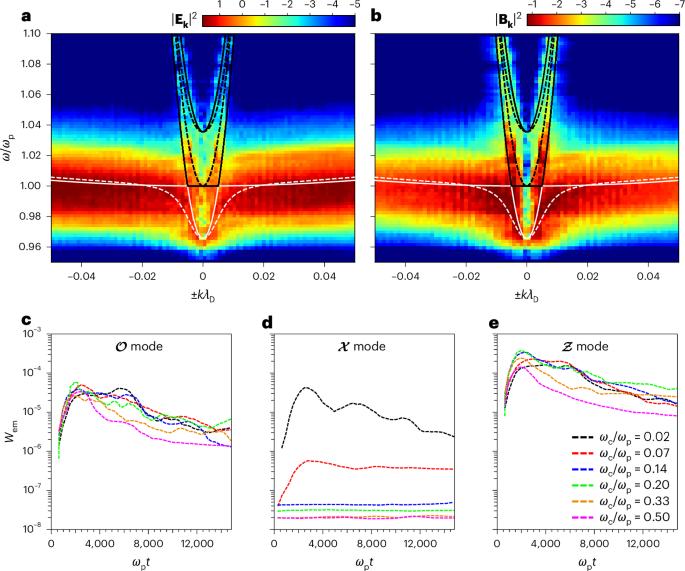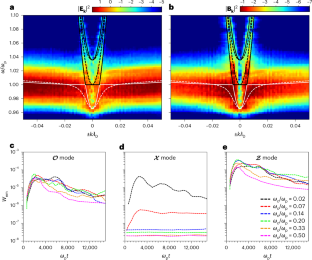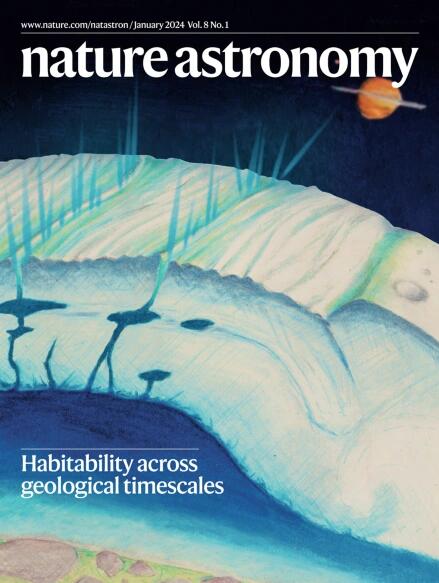波束产生的太阳射电源电磁波模式的辐射效率
IF 14.3
1区 物理与天体物理
Q1 ASTRONOMY & ASTROPHYSICS
引用次数: 0
摘要
在III型太阳射电爆发期间,由随机非均匀太阳风和日冕等离子体中从太阳喷射出的电子束产生的静电波湍流以等离子体频率ωp及其谐波辐射电磁波。几十年来,宇宙飞船和射电望远镜探测到这些辐射,它们被等离子体磁场分成三种模式,\({\mathcal{X}}\)、\({\mathcal{O}}\)和\({\mathcal{Z}}\),具有不同的色散、极化和辐射特性。在这里,我们使用三种独立和收敛的方法——细胞内粒子模拟、随机介质中的波的理论模型和湍流理论框架中的解析计算——证明了只有一小部分电磁能量在ωp(> 10)处辐射%) escapes from beam-generated radio sources, mainly as \({\mathcal{O}}\)-mode waves and, depending on plasma conditions, as \({\mathcal{X}}\)-mode waves. Most energy is radiated in the \({\mathcal{Z}}\)-mode and can therefore be observed only close to sources. The results provide strong support for interpretation of observations performed up to close distances from the Sun by spacecraft such as Parker Solar Probe and Solar Orbiter. This work, based on general approaches requiring few assumptions, makes it possible to study the properties of radio emission under realistic solar conditions, and thereby provides a solid basis for the development of theoretical tools for probing space and time variations of beam–plasma systems in the solar wind.本文章由计算机程序翻译,如有差异,请以英文原文为准。


Radiation efficiency of electromagnetic wave modes from beam-generated solar radio sources
During type III solar radio bursts, electromagnetic waves are radiated at the plasma frequency ωp and its harmonics by electrostatic wave turbulence generated by electron beams ejected from the Sun in randomly inhomogeneous solar wind and coronal plasmas. These emissions, detected for decades by spacecraft and radiotelescopes, are split by the plasma magnetic field into three modes, $${\mathcal{X}}$$ , $${\mathcal{O}}$$ and $${\mathcal{Z}}$$ , with different dispersion, polarization and radiation properties. Here, using three independent and converging approaches—particle-in-cell simulations, a theoretical model of waves in a random medium and analytical calculations in the framework of turbulence theory—we demonstrate that only a small fraction of electromagnetic energy radiated at ωp (≲10%) escapes from beam-generated radio sources, mainly as $${\mathcal{O}}$$ -mode waves and, depending on plasma conditions, as $${\mathcal{X}}$$ -mode waves. Most energy is radiated in the $${\mathcal{Z}}$$ -mode and can therefore be observed only close to sources. The results provide strong support for interpretation of observations performed up to close distances from the Sun by spacecraft such as Parker Solar Probe and Solar Orbiter. This work, based on general approaches requiring few assumptions, makes it possible to study the properties of radio emission under realistic solar conditions, and thereby provides a solid basis for the development of theoretical tools for probing space and time variations of beam–plasma systems in the solar wind. Three independent theoretical approaches are used to assess the efficiency of the electromagnetic wave mode radiation at the plasma frequency from beam-generated sources during type III solar radio bursts, with parameters close to realistic conditions.
求助全文
通过发布文献求助,成功后即可免费获取论文全文。
去求助
来源期刊

Nature Astronomy
Physics and Astronomy-Astronomy and Astrophysics
CiteScore
19.50
自引率
2.80%
发文量
252
期刊介绍:
Nature Astronomy, the oldest science, has played a significant role in the history of Nature. Throughout the years, pioneering discoveries such as the first quasar, exoplanet, and understanding of spiral nebulae have been reported in the journal. With the introduction of Nature Astronomy, the field now receives expanded coverage, welcoming research in astronomy, astrophysics, and planetary science. The primary objective is to encourage closer collaboration among researchers in these related areas.
Similar to other journals under the Nature brand, Nature Astronomy boasts a devoted team of professional editors, ensuring fairness and rigorous peer-review processes. The journal maintains high standards in copy-editing and production, ensuring timely publication and editorial independence.
In addition to original research, Nature Astronomy publishes a wide range of content, including Comments, Reviews, News and Views, Features, and Correspondence. This diverse collection covers various disciplines within astronomy and includes contributions from a diverse range of voices.
 求助内容:
求助内容: 应助结果提醒方式:
应助结果提醒方式:


